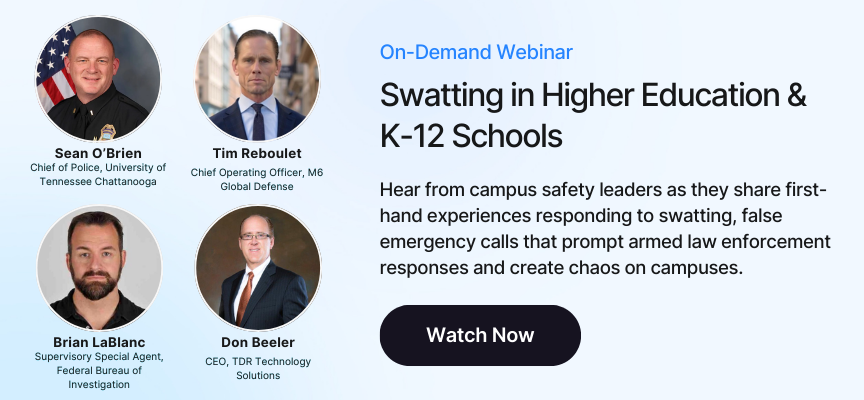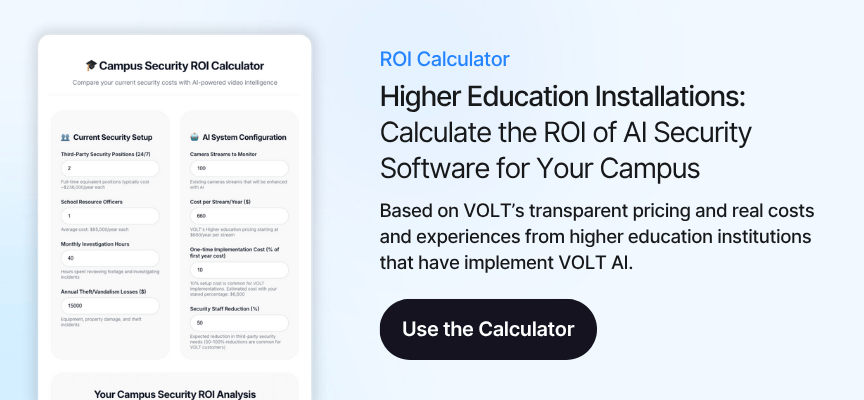Key Points
- Instant swatting threat verification: AI-powered video intelligence systems analyze camera feeds in real-time to confirm or contradict reported threats within seconds, helping schools distinguish genuine emergencies from false alarms
- Evidence-based decision making: Video intelligence provides security teams and first responders with concrete visual evidence to assess swatting threat credibility before committing resources to full emergency response
- Seamless integration: Modern AI systems connect with existing emergency protocols, 911 systems, and campus safety infrastructure without requiring complete operational overhauls
- Privacy-first verification: Advanced platforms verify swatting threats through behavior-focused detection rather than facial recognition, protecting student and staff privacy while maintaining security effectiveness
- Measurable impact: Schools using AI-powered verification reduce false alarm responses by up to 60%, lower operational costs, and minimize the psychological trauma swatting threats inflict on their communities
The Swatting Threat Crisis: When False Emergencies Overwhelm Campus Safety
School administrators face an unprecedented swatting threat crisis. False emergency reports have escalated dramatically, with monthly incidents now impacting over 780 schools nationwide according to K-12 School Shooting Database tracking. Each swatting threat triggers massive emergency responses, disrupts learning, and creates lasting anxiety for students and staff.
The financial impact of swatting threats tells a sobering story. According to the FBI's analysis of school swatting incidents, average costs per incident range from $60,000 to $900,000 in lost instructional time, emergency response expenses, and mental health support services.
Traditional security measures struggle with a fundamental problem when responding to swatting threats. When a threat arrives via phone call, email, or social media, security teams have limited tools to verify its credibility before the emergency machinery activates. Dispatch centers receive the call. First responders mobilize. Buildings lockdown. Parents panic.
The question becomes urgent: How can schools verify swatting threats in real-time before disruption cascades across campus?
Real-Time Visual Intelligence: Seeing What Swatting Callers Only Claim
AI-powered video intelligence transforms existing security cameras into active swatting threat verification tools. These systems analyze video feeds continuously, detecting specific behaviors, objects, and situations that indicate genuine emergencies versus fabricated swatting threats.
The technology operates differently from passive camera systems. Traditional security cameras record footage for later review. AI-powered systems process visual data in real-time, identifying relevant patterns and anomalies as they occur. The distinction matters critically when seconds determine whether a swatting threat is real.
Video intelligence provides swatting threat verification through multiple analytical approaches. The system detects weapons, unusual crowd movements, individuals in distress, and unauthorized access patterns. When a swatting threat report arrives, security teams can immediately reference what cameras actually show versus what the caller claims.
How Swatting Threat Verification Works in Practice
The University of Tennessee Chattanooga experienced this verification capability during a swatting incident. When dispatchers received a call reporting an active shooter in the library, the security team had AI-powered cameras monitoring that exact location.
Within seconds, they confirmed no weapons were visible. No unusual activity appeared on any camera feed. No system alerts triggered despite the claimed shooting. The visual evidence directly contradicted the swatting threat report, enabling a measured response rather than full emergency escalation.
This verification prevented the typical cascade of disruption from swatting threats. Students remained in class. First responders approached strategically rather than at emergency speed. The incident resolved in hours instead of consuming entire days of instructional time.
The contrast with unverified swatting threat responses proves stark. Schools without verification tools often evacuate buildings, dismiss students early, and trigger massive law enforcement responses based solely on unconfirmed reports.
Read our guide to AI-Powered School Security.
Integration With Emergency Response: Building Swatting Threat Verification Into Existing Protocols
AI-powered verification systems succeed only when they integrate seamlessly with established emergency procedures for handling swatting threats. Schools already maintain complex protocols involving dispatch centers, law enforcement partnerships, campus security teams, and administrative decision-makers.
Effective video intelligence platforms connect with these existing systems rather than requiring separate operational workflows for swatting threat response. The technology feeds information into current decision-making processes, enhancing rather than replacing human judgment.
Critical Integration Points for Swatting Threat Response
Emergency response integration requires connection at several key stages when addressing swatting threats. The following table outlines where AI verification intersects with standard campus safety protocols:
Response Stage | Traditional Approach | AI-Enhanced Swatting Threat Verification |
Threat Receipt | Dispatcher receives call or report | System checks relevant camera feeds automatically |
Initial Assessment | Limited information from caller description | Real-time visual confirmation of reported conditions |
Resource Deployment | Full emergency response activation | Scaled response based on verified threat level |
On-Scene Verification | First responders conduct physical search | Officers arrive with situational awareness from video analysis |
All-Clear Determination | Manual building-by-building clearance | Systematic verification through monitored camera coverage |
Integration extends beyond technical connections for swatting threat response. Schools must train dispatch personnel to incorporate video intelligence findings into their assessment process. Security teams need clear protocols for when visual evidence contradicts swatting threat reports.
Campus police at UT Chattanooga emphasized this trained response in their swatting experience. Their security operations center had established procedures for cross-referencing threat calls with camera system data. When the library shooting was reported, trained operators immediately pulled relevant feeds and communicated findings to responding officers.
Connecting Swatting Threat Verification With 911 Systems
The dispatcher relationship proves especially critical when responding to swatting threats. When threats arrive through 911 calls, regional emergency centers often control initial response decisions. These centers may not have direct access to campus video systems or training in swatting threat verification protocols.
Schools need established communication channels between campus security and regional dispatch for effective swatting threat response. Some districts implement liaison programs where campus security contacts dispatch immediately when AI systems show no verification of reported threats. Other schools provide dispatch centers with secure access to campus video feeds during emergencies.
The FBI training program on swatting identification has helped standardize these connections. Law enforcement and dispatch personnel learn characteristic patterns of swatting threats alongside verification techniques using available technology resources.
Corroboration and Contradiction: How Visual Evidence Informs Swatting Threat Response
AI-powered video intelligence serves two distinct verification functions when addressing swatting threats. The system either corroborates threat details, confirming emergency response is warranted, or contradicts reported claims, indicating likely hoax activity.
Corroboration occurs when visual evidence matches swatting threat descriptions. A caller reports a weapon in a specific location. Cameras detect that weapon. Unusual crowd behavior appears consistent with emergency conditions. Multiple visual indicators align with the reported threat.
These corroborated threats receive full emergency response with video intelligence providing tactical advantages. First responders know exact locations, current conditions, and movement patterns before arrival. Response teams deploy more effectively with enhanced situational awareness.
Contradiction presents different value when responding to swatting threats. When visual evidence directly opposes threat claims, schools can pursue measured responses that protect safety while minimizing disruption.
Characteristic Patterns of Swatting Threats
Certain visual patterns consistently indicate swatting threats according to FBI analysis of hoax incidents. AI-powered systems can identify these contradictory indicators within swatting threat scenarios:
- Single source reporting: No corroborating calls or social media posts appear despite claimed active emergency
- Normal activity patterns: Camera feeds show routine behavior inconsistent with reported violence
- Absence of claimed elements: Reported weapons, crowds, or disturbances are not visible in relevant coverage areas
- Timing anomalies: Threat timing doesn't match observed campus activity levels or patterns
Schools trained in these swatting threat patterns can identify likely hoaxes within the first minutes of threat receipt. Video intelligence automates this pattern recognition, flagging contradictions immediately rather than requiring manual review of multiple camera feeds.
The University of Illinois Chicago leveraged this capability effectively across their 250-acre campus during multiple swatting threat incidents. Their AI system monitors 142 critical camera streams continuously.
The Human Decision Framework for Swatting Threat Verification
Technology provides evidence when responding to swatting threats. Humans make decisions. This balance remains essential in threat verification. AI systems analyze visual data and present findings. Security leaders assess those findings within broader context including prior swatting threat patterns, current events, and specific campus knowledge.
Effective verification protocols establish clear decision trees for swatting threat response. When do contradictory findings warrant continued investigation versus immediate all-clear? How much visual confirmation is needed before concluding a swatting threat is real? Which staff members hold authority to make verification-based decisions?
Schools that answer these questions before swatting threats occur respond more effectively when threats arrive.
Privacy Considerations: Verifying Swatting Threats Without Compromising Student Rights
Video intelligence for swatting threat verification raises legitimate privacy concerns. Students, staff, and families rightfully question surveillance expansion even for safety purposes. Schools must balance effective swatting threat verification with privacy protection.
Modern AI systems address privacy through technical design rather than policy alone when verifying swatting threats. The technology can verify threats without identifying individuals or tracking personal information.
Privacy-Preserving Swatting Threat Detection Methods
AI-powered verification for swatting threats focuses on behaviors and objects rather than personal identity. The system detects:
- Behavior patterns: Unusual movements, gatherings, or activities indicating potential emergencies
- Object recognition: Weapons, abandoned items, or other threat indicators
- Situational analysis: Environmental conditions suggesting safety concerns
- Spatial monitoring: Access to restricted areas or unusual facility usage
These detection methods avoid facial recognition entirely when verifying swatting threats. The system identifies that a person exhibits concerning behavior but not who that person is. Verification occurs without creating personal identification databases or tracking individual movements over time.
VOLT AI's approach exemplifies privacy-conscious swatting threat verification. The platform analyzes video feeds for security-relevant patterns while maintaining privacy protections. Students and staff are represented as behavioral data points rather than identified individuals.
Compliance With Educational Privacy Standards During Swatting Threat Response
Schools operate under strict privacy regulations including FERPA (Family Educational Rights and Privacy Act) and various state-level student privacy laws. Video intelligence implementation for swatting threat verification must align with these requirements.
Privacy-compliant verification systems for swatting threats incorporate several protective measures:
- Data minimization: Recording only essential information for threat verification
- Limited retention: Storing video data for defined periods rather than indefinitely
- Access controls: Restricting system access to authorized security personnel only
- Audit trails: Maintaining records of who accesses video data and when
- Encryption standards: Protecting video feeds and stored data through robust encryption
Schools should conduct privacy impact assessments before implementing video intelligence systems for swatting threat verification. These assessments identify potential privacy risks and establish mitigation strategies aligned with applicable regulations.
Transparency With School Communities About Swatting Threat Verification
Privacy protection extends beyond technical measures when implementing swatting threat verification. Schools must communicate clearly with students, staff, and families about video intelligence capabilities and limitations.
Effective transparency for swatting threat verification includes:
- Clear purpose statements: Explaining that video systems serve threat verification rather than general surveillance
- Capability descriptions: Detailing what the system can and cannot detect during swatting threat incidents
- Privacy safeguards: Describing technical protections preventing misuse
- Oversight mechanisms: Establishing accountability for appropriate system usage
Prescott High School demonstrated this transparency when implementing their AI-enhanced security system. The administration communicated with parents and community members about privacy protections, emphasizing behavior-focused detection without personal identification. This transparency built support for enhanced verification capabilities.
Operational Impact: What Swatting Threat Verification Technology Delivers
Schools implementing AI-powered verification for swatting threats report measurable improvements across multiple operational areas. The technology delivers value beyond threat verification itself.
Response efficiency increases significantly when schools can verify swatting threats. Security teams spend less time investigating false alarms and more time addressing genuine safety concerns. First responders arrive with situational awareness that improves tactical effectiveness. Campus operations experience fewer unnecessary disruptions from swatting threat hoaxes.
The psychological impact of effective swatting threat verification matters equally. Students and staff develop greater confidence in campus safety when they know threats receive systematic verification. The constant anxiety from repeated false alarms diminishes. Learning environments stabilize.
According to research on school safety technology effectiveness, institutions using AI-powered verification reduce false alarm responses by up to 60% and decrease average response resolution time by 75%.
Building Swatting Threat Verification Into Campus Safety Culture
Technology succeeds when paired with trained personnel and established procedures for swatting threat response. Schools that integrate video intelligence most effectively invest in training across multiple roles:
- Security personnel: Understanding system capabilities, interpreting alerts, incorporating findings into swatting threat response decisions
- Administrative leadership: Knowing when verification findings warrant operational decisions like shelter-in-place versus evacuation
- Dispatch and communication staff: Incorporating video intelligence into swatting threat assessment and response coordination
- Law enforcement partners: Sharing verification findings with responding agencies for coordinated tactical response
This training transforms swatting threat verification technology from a tool into a systematic capability. Schools develop institutional knowledge about effective threat assessment using available resources.
The Future of Swatting Threat Verification: Where Technology Leads Next
Video intelligence for swatting threat verification continues evolving rapidly. Current systems provide powerful verification capabilities. Emerging developments will expand those capabilities further.
Advanced behavioral analysis will detect increasingly subtle indicators of legitimate threats versus swatting hoaxes. Systems will recognize early warning signs that precede emergencies, enabling truly proactive intervention. Integration with other campus technologies including access control, environmental sensors, and communication platforms will create comprehensive situational awareness ecosystems for swatting threat response.
Machine learning models will become more sophisticated at distinguishing swatting threat patterns. Systems will identify new hoax techniques as they emerge, automatically updating detection algorithms. Verification accuracy will improve while false positive rates decline.
The fundamental principle remains constant for swatting threat verification. Visual evidence provides objective assessment of threat credibility. Technology delivers that evidence when it matters most, enabling decisions that protect communities while minimizing unnecessary disruption from swatting threats.
Making Swatting Threat Verification Work: Implementation Considerations for School Leaders
School administrators considering AI-powered verification technology for swatting threats should evaluate several key factors. Successful implementation requires careful planning beyond simple technology acquisition.
Infrastructure assessment comes first when building swatting threat verification capabilities. What camera coverage exists currently? Which areas lack visual monitoring? How do existing cameras connect to network systems? Understanding current infrastructure reveals gaps that need addressing before verification capabilities become fully effective.
Integration requirements deserve careful attention for effective swatting threat response. How will video intelligence connect with campus security systems? What protocols need updating to incorporate verification findings? Which personnel require training? Answers to these questions shape implementation timelines and resource needs.
Budget considerations extend beyond initial technology costs when implementing swatting threat verification. Schools must account for infrastructure upgrades, training programs, ongoing system maintenance, and potential staffing adjustments. The investment should be weighed against quantifiable benefits including reduced false alarm costs, decreased emergency response expenses, and minimized instructional time loss from swatting threat incidents.
The verification capability that AI-powered video intelligence provides addresses a critical gap in school safety operations when responding to swatting threats. When threats arrive, schools need immediate tools to separate genuine emergencies from false alarms. Visual evidence delivers that separation objectively and rapidly.
Schools that implement swatting threat verification technology report transformative impacts. Security operations become more effective. Emergency responses scale appropriately to actual threat levels. Campus communities experience reduced anxiety from repeated false alarms.
The path forward for school safety includes systematic swatting threat verification. Technology makes that verification practical, privacy-compliant, and operationally effective. Schools can protect their communities while maintaining the focused learning environments students deserve.







